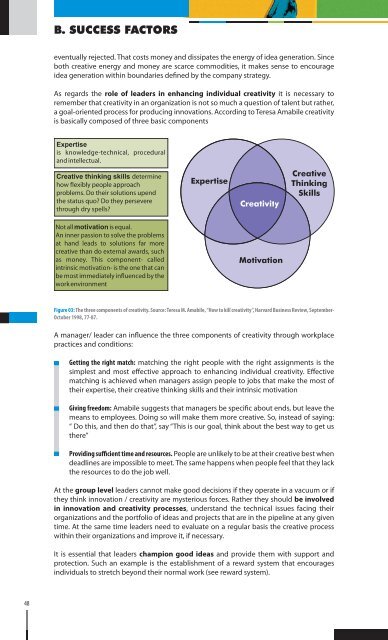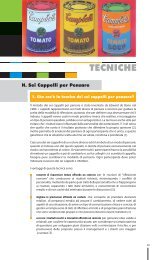Creativity Theory - TRaining MAterial in Creativity and InnovaTion ...
Creativity Theory - TRaining MAterial in Creativity and InnovaTion ...
Creativity Theory - TRaining MAterial in Creativity and InnovaTion ...
You also want an ePaper? Increase the reach of your titles
YUMPU automatically turns print PDFs into web optimized ePapers that Google loves.
48<br />
B. SUCCESS FACTORS<br />
eventually rejected. That costs money <strong>and</strong> dissipates the energy of idea generation. S<strong>in</strong>ce<br />
both creative energy <strong>and</strong> money are scarce commodities, it makes sense to encourage<br />
idea generation with<strong>in</strong> boundaries def<strong>in</strong>ed by the company strategy.<br />
As regards the role of leaders <strong>in</strong> enhanc<strong>in</strong>g <strong>in</strong>dividual creativity it is necessary to<br />
remember that creativity <strong>in</strong> an organization is not so much a question of talent but rather,<br />
a goal-oriented process for produc<strong>in</strong>g <strong>in</strong>novations. Accord<strong>in</strong>g to Teresa Amabile creativity<br />
is basically composed of three basic components<br />
Figure 03: The three components of creativity. Source: Teresa M. Amabile, “How to kill creativity”, Harvard Bus<strong>in</strong>ess Review, September-<br />
October 1998, 77-87.<br />
A manager/ leader can <strong>in</strong>fluence the three components of creativity through workplace<br />
practices <strong>and</strong> conditions:<br />
• Gett<strong>in</strong>g the right match: match<strong>in</strong>g the right people with the right assignments is the<br />
simplest <strong>and</strong> most effective approach to enhanc<strong>in</strong>g <strong>in</strong>dividual creativity. Effective<br />
match<strong>in</strong>g is achieved when managers assign people to jobs that make the most of<br />
their expertise, their creative th<strong>in</strong>k<strong>in</strong>g skills <strong>and</strong> their <strong>in</strong>tr<strong>in</strong>sic motivation<br />
• Giv<strong>in</strong>g freedom: Amabile suggests that managers be specific about ends, but leave the<br />
means to employees. Do<strong>in</strong>g so will make them more creative. So, <strong>in</strong>stead of say<strong>in</strong>g:<br />
“ Do this, <strong>and</strong> then do that”, say “This is our goal, th<strong>in</strong>k about the best way to get us<br />
there”<br />
• Provid<strong>in</strong>g sufficient time <strong>and</strong> resources. People are unlikely to be at their creative best when<br />
deadl<strong>in</strong>es are impossible to meet. The same happens when people feel that they lack<br />
the resources to do the job well.<br />
At the group level leaders cannot make good decisions if they operate <strong>in</strong> a vacuum or if<br />
they th<strong>in</strong>k <strong>in</strong>novation / creativity are mysterious forces. Rather they should be <strong>in</strong>volved<br />
<strong>in</strong> <strong>in</strong>novation <strong>and</strong> creativity processes, underst<strong>and</strong> the technical issues fac<strong>in</strong>g their<br />
organizations <strong>and</strong> the portfolio of ideas <strong>and</strong> projects that are <strong>in</strong> the pipel<strong>in</strong>e at any given<br />
time. At the same time leaders need to evaluate on a regular basis the creative process<br />
with<strong>in</strong> their organizations <strong>and</strong> improve it, if necessary.<br />
It is essential that leaders champion good ideas <strong>and</strong> provide them with support <strong>and</strong><br />
protection. Such an example is the establishment of a reward system that encourages<br />
<strong>in</strong>dividuals to stretch beyond their normal work (see reward system).



